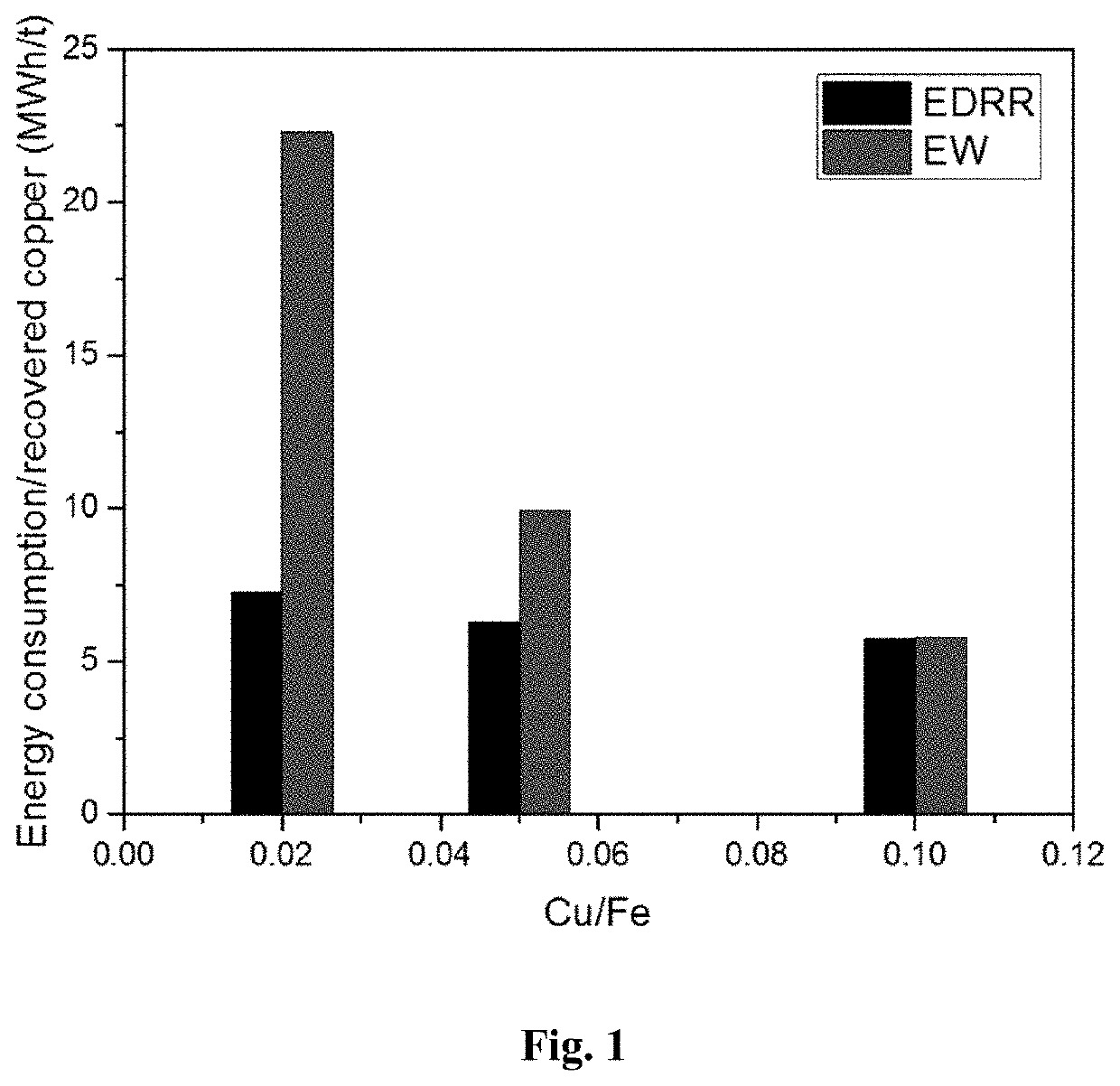Method of recovering copper from a dilute metal containing solution
a metal containing solution and copper technology, applied in the field of recovering copper, can solve the problems of acidic metal containing water in mines containing sulphide minerals, harmful waste to the environment, wastewater from abandoned sulphide mines, etc., and achieve the effect of reducing energy consumption
- Summary
- Abstract
- Description
- Claims
- Application Information
AI Technical Summary
Benefits of technology
Problems solved by technology
Method used
Image
Examples
example 1
nsumption
[0050]Energy consumption of the method according to the present invention (EDRR) and a traditional electrowinning method (EW) were tested in copper recovery from synthetic solutions having a Cu / Fe ratio of 0.02, 0.05 and 0.1 (copper concentration of 2, 5 or 10 ppm and Fe concentration of 100 ppm).
[0051]Recovery of copper on stainless steel working electrode (area 16 cm2) was performed in 2000 ml of solution (solution parameters: [Fe]=100 mg / L, [Cu]=1-10 mg / L, [H2SO4]=10 g / L, pH=1), with magnetic stirring at 400 rpm. A standard calomel electrode (SCE) was acting as a reference electrode (RE) and stainless steel as a counter electrode (CE).
[0052]Solution samples were taken at the following time points: before, 1, 5, 10, 20, 30, and 60 min, and the amount of copper was detected by ICP. In EDRR, the potential applied to the electrode during the electrodeposition (ED) step was −0.55 V vs. SCE (Edeposition=−0.55 V vs. SCE), the deposition time was 10 s, the cut-off potential for ...
example 2
f the Product (Tests from Synthetic Mine Waters and from a Real Mining Water)
[0059]The method was tested in synthetic solutions with additional impurities (e.g. Zn, Al, Pb), i.e. mimicking real mine waters. The composition of 10 g / l H2SO4 solutions is shown in Table 3, together with the achieved product quality (Cu / Fe) after applying EDRR method in each synthetic mine water solution. The product quality was determined by SEM-EDX analysis from Pt working electrode after 10 EDRR cycles (EED=−0.45 V vs. SCE for Solutions 1 & 2 and EED=−0.50 V vs. SCE for Solution 3, time of the step=10 s for each solution, Ecut-off=0.30 V vs. SCE for each solution) while using Pt sheet as working electrode (0.4 cm2), Pt sheet as counter electrode and standard calomel electrode (SCE) as reference electrode.
[0060]
TABLE 3Synthetic mine waters and achievedproduct quality from SEM analysisProduct QualitySolution[Cu][Fe][Zn][Al][Pb]from SEMComposition(ppm)(ppm)(ppm)(ppm)(ppm)(Cu / Fe)Solution 1100400080——1.9So...
example 3
Cycling Between the Steps
[0064]The effect of cycling on the quality of the product was investigated in a synthetic solution ([Cu]=100 mg / L, [Fe]=4 g / dm3, pH=1.2, [H2SO4]=10 g / L). The chemicals used for preparing the solution were FeSO4.7H2O, CuSO4.5H2O and concentrated H2SO4. Electrodeposition potential was −0.60 V vs. SCE, deposition time 10 s, and cut-off potential for redox replacement step +0.25 V vs. SCE. The working electrode was Pt sheet (0.4 cm2 area), counter electrode was Pt sheet and reference electrode a standard calomel electrode (SCE).
[0065]The results in FIG. 2 show that the quality of copper product (shown as Cu / Fe ratio) is not effected by the number of cycles, but the copper concentration is approximately three times higher compared to iron regardless of the number of cycles.
PUM
| Property | Measurement | Unit |
|---|---|---|
| Fraction | aaaaa | aaaaa |
| Fraction | aaaaa | aaaaa |
| Fraction | aaaaa | aaaaa |
Abstract
Description
Claims
Application Information
 Login to View More
Login to View More - Generate Ideas
- Intellectual Property
- Life Sciences
- Materials
- Tech Scout
- Unparalleled Data Quality
- Higher Quality Content
- 60% Fewer Hallucinations
Browse by: Latest US Patents, China's latest patents, Technical Efficacy Thesaurus, Application Domain, Technology Topic, Popular Technical Reports.
© 2025 PatSnap. All rights reserved.Legal|Privacy policy|Modern Slavery Act Transparency Statement|Sitemap|About US| Contact US: help@patsnap.com


